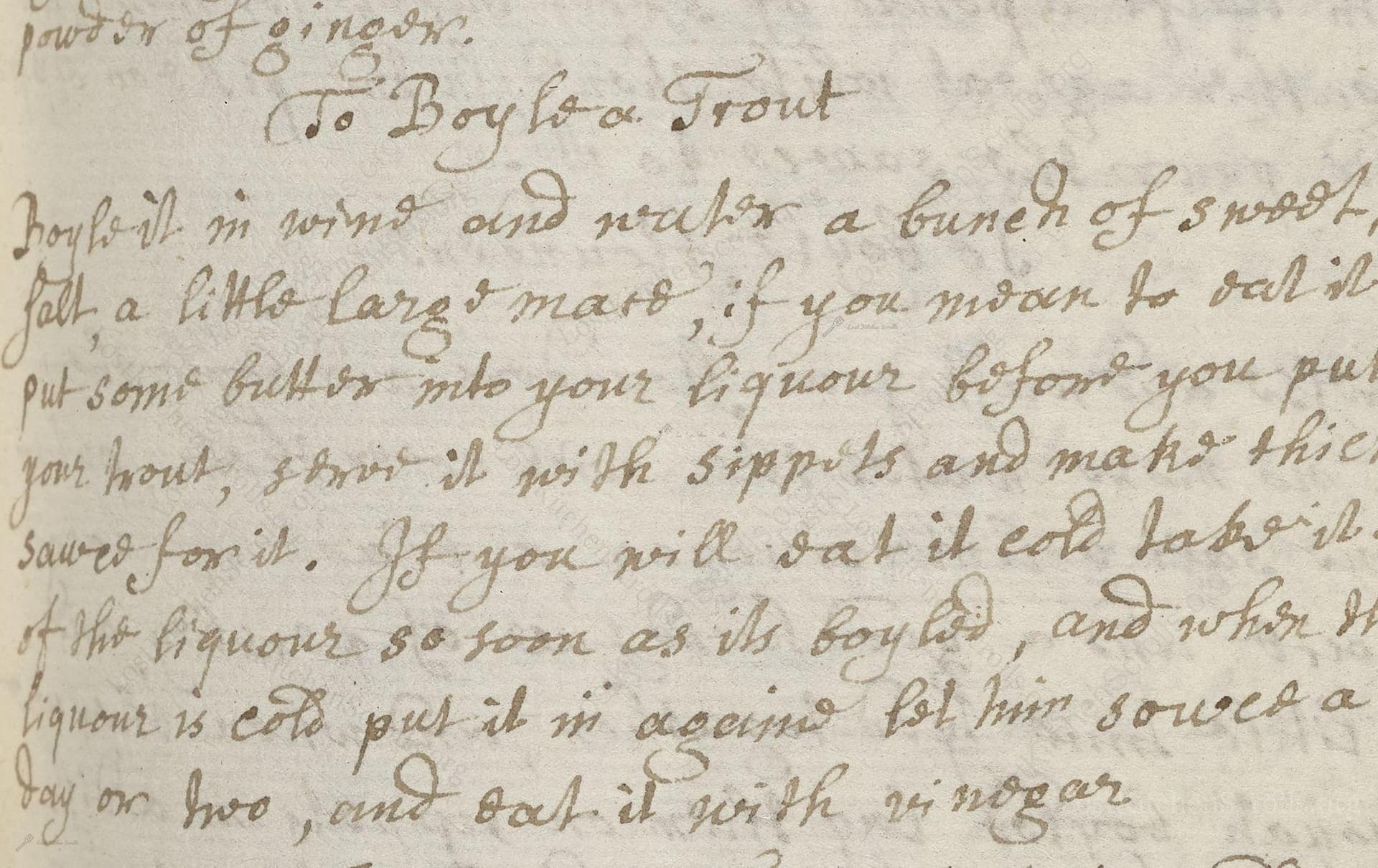To Boyle A Trout
From the treasured pages of Manuscript cookery book
Unknown Author

To Boyle A Trout
"boyle it in wine and water a bunch of sweet herbs, salt, a little large mace, if you meane to eat it hot put some butterr into your liquor before you put in your trout, serve it with sippets and make thicke sawce for it. if you will eat it cold take it out of the liquor so soone as its boyled, and when the liquor is cold put it in againe let him soake a day or two, and eat it with vinegar."
Note on the Original Text
This recipe employs the spelling and grammar conventions of late 17th-century English. 'Boyle' here means 'boil,' though a gentle simmer was actually intended to avoid breaking up the delicate fish. Instructions are brief, presupposing the reader's basic kitchen knowledge and omitting strict measurements, as home cooks then worked by intuition and experience. Component instructions are merged into a single sentence, with ad hoc recommendations (such as eating hot or cold), illustrating the recipe's adaptability. Notable spelling: 'liquor' for cooking liquid, 'sippets' for bread pieces.

Title
Manuscript cookery book (1680)
You can also click the book image above to peruse the original tome
Writer
Unknown
Era
1680
Publisher
Unknown
Background
A tantalizing window into the kitchens of yesteryear, this late-17th century collection presents recipes and culinary wisdom meant to delight and surprise even the most discerning of historical gourmands.
Kindly made available by
Folger Shakespeare Library
This recipe comes from a late 17th-century English manuscript household cookbook, a time when home cooking was transitioning from medieval traditions to more recognizable European fare. Fish, especially trout, was highly prized and often prepared for special occasions or fast days. Steeping the cooked fish in its liquor, especially with aromatics and a touch of wine, reveals the blending of preservation and flavor enhancement in period cooking. The instructions reflect both the flexibility and the resourcefulness of early modern English cooks: the same basic preparation suited both hot service direct from the pot and cold service after marinating for several days.

In its time, this trout dish would have been cooked over an open fire in a large heavy pot, likely copper or earthenware. Fish was commonly cooked in a 'fish kettle' or deep pan, and utensils included wooden spoons and long-handled ladles. Bread for sippets would be toasted on a hearth or skillet. For the thickened sauce, cooks might use a smaller saucepan and a whisk or wooden spoon to stir eggs or flour into the buttery sauce.
Prep Time
10 mins
Cook Time
15 mins
Servings
2
We've done our best to adapt this historical recipe for modern kitchens, but some details may still need refinement. We warmly welcome feedback from fellow cooks and culinary historians — your insights support the entire community!
Ingredients
- 1 whole trout (1–1.5 lb), cleaned
- 2 cups white wine
- 2 cups water
- 1 small bunch mixed sweet herbs (parsley, marjoram, thyme, etc.)
- 1 teaspoon salt
- 1/4 teaspoon whole mace or 1/2 teaspoon ground mace
- 3 1/2 tablespoons unsalted butter (optional, for hot version)
- Bread sippets (toast or fried bread slices)
- Vinegar (for cold version)
- Thickened sauce, such as velouté or egg-thickened butter sauce (for serving hot)
Instructions
- To prepare this historical trout dish, start by simmering a whole cleaned trout (about 1–1.5 lb) in a mixture of around 2 cups white wine and 2 cups water.
- Add a small bunch of mixed fresh sweet herbs—such as parsley, thyme, and marjoram—along with 1 teaspoon of salt and 1/4 teaspoon of whole mace or 1/2 teaspoon ground mace.
- If you wish to serve the trout hot, stir in 3 1/2 tablespoons unsalted butter before adding the trout, and cook gently until just done (about 10–15 minutes).
- Serve the hot trout with slices of bread (sippets), and accompany with a thickened sauce of your choosing (such as egg-thickened butter sauce).
- For a cold version, remove the trout from the cooking liquid as soon as it's cooked, cool the liquor completely, then return the trout to soak for one or two days in the refrigerator.
- Serve the cold fish with vinegar.
Estimated Calories
350 per serving
Cooking Estimates
It takes about 10–15 minutes to cook the trout, plus another 10 minutes to prepare ingredients and set up. Each serving has around 350 calories. This recipe serves 2 people.
As noted above, we have made our best effort to translate and adapt this historical recipe for modern kitchens, taking into account ingredients nowadays, cooking techniques, measurements, and so on. However, historical recipes often contain assumptions that require interpretation.
We'd love for anyone to help improve these adaptations. Community contributions are highly welcome. If you have suggestions, corrections, or cooking tips based on your experience with this recipe, please share them below.
Join the Discussion
Rate This Recipe

Den Bockfisch In Einer Fleisch Suppen Zu Kochen
This recipe hails from a German manuscript cookbook compiled in 1696, a time whe...

Die Grieß Nudlen Zumachen
This recipe comes from a rather mysterious manuscript cookbook, penned anonymous...

Ein Boudain
This recipe comes from an anonymous German-language manuscript cookbook from 169...

Ein Gesaltzen Citroni
This recipe, dating from 1696, comes from an extensive anonymous German cookbook...
Browse our complete collection of time-honored recipes



